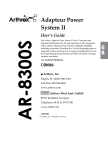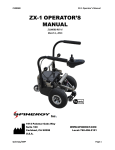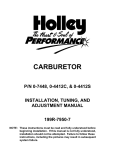Download Stag Engine Rebuild - Part 1
Transcript
SPRING 2013 • ISSUE 79 Stag Engine Rebuild - Part 1 TOP END RECONDITIONING by Tony Fox Quite often, the reason for a Stag engine rebuild is overheating and blown head gaskets more than simply wear out and old age. Triumph Stags as well as TR 7s when subjected to an overheated cooling system often suffer blown head gaskets. They are not alone as many engines with aluminum heads suffer the same result when overheated due to differential expansion of the aluminum head and iron blocks. The overheating and blown gasket quite often causes warping of the cylinder heads and subsequently necessitates some serious repairs. These engines may be more vulnerable than most as the water pump sits high in the system and, a small loss of coolant can leave it running dry, but probably by that time it’s too late anyway. HEAD REMOVAL First off, obviously you need to remove the heads. “Easy you say, done that many times”. Stag and TR7 heads (as in old Jaguars) are notorious for seizing on the studs. This is a major problem if indeed they are stuck (and most are) because the force required to remove them is considerable. The heads are retained by a row of bolts (relatively short) which invariably come out easily. In addition to these, there is a row of longer studs which are angled to the block face. They were designed on an angle to allow simpler maintenance; you could tighten the nuts without removing the valve cover. The studs and head fuse together due to corrosion inside the drilled holes in the heads and are often well and truly stuck. Usually, in this instance, trying to remove the studs by the normal extractor method ends up shearing off the end of the stud. So now 10 you have a seized stud and the end of it is now sheared off flush with the head. I had one that I tried every known trick to remove, soaked the studs in penetrating oil and diesel oil for a year. Even swinging at it in a very unprofessional manner with a sledgehammer, it still would not budge. A local experienced engine shop suggested shocking the studs with an electric welder. Sitting on the tailgate of my truck all that did was start a fire around the tailgate but the head would not budge I’ve tried welding nuts to the end of the stud and then using an impact gun, you can shear the ends off before any movement. Some users have had success with the ‘rope trick’ which is to stuff rope into the cylinder and then crank the engine compressing the rope and pushing up on the head, this has limited success and does not work in most cases. When the heads are eventually off you will find it necessary to press out the studs, that’s how tight they are stuck. Talking to the man with the most experience on Stag engines in the UK, Tony Hart (always helps to speak with those who know) he recommended forcing one head off against the other, said this is the only way and it will work. I had previously thought of pushing on the heads with a counteracting force on the crankshaft but was concerned about damage to the crankshaft and bearing caps. His advice was to loosen one head as far as possible and then push against the other which was still bolted down. This worked a treat, off came the head in no time at all, after all the struggling it was solved. When the first one is loose, you reverse the procedure and refit it and loosen the second head. HEAD CONDITION, IS IT SAVABLE? If the joint faces of the heads look OK and there is no apparent warping, remove the cam follower buckets and tighten the heads down. Install the camshafts and see if they are free to turn, you should be able to turn them comfortably by hand which indicates and confirms if there is any warping. In addition, when you get the heads on the bench. run a straight edge across them and see if there is any visible distortion. Remember, if you machine a warped head then the camshaft bores are probably out of line too so will need line boring or alternatively, have the head straightened before machining. Often heads have been machined on previous occasions, so where is the limit you ask? There is a dimension provided by British Leyland but that barely gets you past the first skim. The general rule of thumb that has been adopted is that when you skim the head, does the cutter touch the inlet valve? If it does not, you can happily rebuild the engine using standard head gaskets. If you consider machining isn’t needed as the faces are simply too good, you can do a check of the head thickness by laying a straight edge across the face. If the inlet valves are at or below the straight edge then you can use a standard gasket for the rebuild. If the inlet valve edge stands above the face you must use a thicker gasket. What you have to know is that heads being machined down causes the valves to get very close to the pistons and contact can be made particularly on the high compression engines of European specification. The North American specification engines had a low compression piston with a bowl in the piston crown so had a little SPRING 2013 • ISSUE 79 more clearance. In addition, removing material from the heads brings them closer to the crankshaft, which retards the valve timing slightly. As the combustion chamber slopes up to the head face, where the slope reaches the machined head face you will find a small step, on a new head this step is about 0.060ins high. When you consider the head ready for assembly, examine the head to block face and make sure the area that will be the gasket ‘fire ring’ seal area is absolutely free of scratches or faults. You can suffer abnormalities on other areas but not in this critical region, it could lead to a blown gasket. Remember, these heads are aluminum and can get damaged on this face quite easily so handle with care. Now, if the valve head outer lip is proud of the head face, a solution has been developed, again by Tony Hart in the UK. Many years ago he developed a gasket with an extra 0.20 ins thickness added. If that fails to satisfy your needs, you can also get a ‘head saver steel shim’ which picks up a further 0.020 ins. So, having saved the head by machining the face, where do we go next? There are a few other important considerations: the camshaft bearings in the heads often get scored, particularly the rearmost ones. This may require the bearings to be line bored to clean up the surface or better still have a bearing insert added. Unfortunately, these are not available as repair kits. However, Stag Parts USA can have these repaired for you. Also, it is quite common to find some of the threads in the aluminum in poor condition if not completely stripped. It is far better to bite the bullet and rethread ALL the threads in the soft aluminum with a Helicoil insert or similar, they do a good job of restoring poor threads. This even extends to the spark plug thread as I’ve known one blow out of the head, so don’t take a chance, restore the threads. It is not a satisfying feeling to put the heads and inlet manifold all back together and have the last bolt go soft on you as the thread strips, so make sure they are good before you get that far. It is quite difficult to add Helicoil inserts (some impossible) with the heads in place in the engine bay. So, do it before assembly into the car. Remember, some of these heads are 40 years old by now and have seen a lot of service and repairs in that time. Not all mechanics over the years have been sympathetic to these engines. you have a manifold which doesn’t fit good heads if you should have to change them down the road. Another factor is, the raised manifold causes some of the coolant passages to be out of line, not desirable. So, it is important to get the heads around the original height with the correct gaskets and shims or replace the heads with better ones. In addition, higher compressions will have you looking for and paying for high-octane gas. While the heads are off why not install harder valves that are suitable for unleaded fuel. I’ve never heard of a valve problem with these heads but as you are fitting new valves anyway get the harder ones which are readily available. Besides which, the old valves and seats have, we are told, a ‘lead memory’ from years of use with leaded gas. The new ones you just installed of course do not have this characteristic. Make sure the valve springs have the steel collar under them where they sit on the head, without these rapid wear of the aluminum will occur (it has been known). The camshafts are usually OK, maybe a slight scoring on the bearing journals but are probably OK. I like to balance the combustion chambers, all eight of them. This makes for a much smoother running engine. Get the chambers within a 1.0 cc spread for best results. If you have to use a thick gasket one side and not the other you need to compensate for this when balancing the chambers, probably easier to get both heads the same dimension to avoid this. If the head has had significant machining to the joint face bringing it lower to the engine block, this has the effect of retarding the valve timing and raising the compression ratio, both of which are unwanted. Raising the compression ratio can cause pinging and extra stress on the head gasket accompanied by potential overheating. The retarded valve timing will cost you a small amount of power, again unwanted. The inlet manifold may need facing off to compensate or the holes to the head won’t line up. Then When you come to reassemble the heads on the engine, use some ‘Never Seize’ compound on the head studs, Copper Slip or other such product, you will never have a stuck head again. Of course, that is academic, as after your rebuild the heads will never need to come off again. It is a good idea to use new studs and nuts too as you don’t know if the old ones have been stretched and are probably corroded. Use the correct hardened washers under the nuts too. Check the cam followers for wear on the cam lobe follower contact face, look for breakdown of the hardened surface and pitting of the followers which if present means the case hardened surface has been compromised. Examine carefully the bores for the followers in the head, it is common to have wear ridges at the bottom of the bores at the limit of the followers travel. With different adjustment of the valve settings these ridges will often cause a ticking noise that sounds like the valve clearances are incorrect but in fact it is the cam follower bucket hitting this ridge. Incidentally, oversize cam follower buckets are available should your bores be in worn condition. Continued next issue... 11 SUMMER 2013 • ISSUE 80 Stag Engine Rebuild - Part 2 TOP END RECONDITIONING by Tony Fox Continued from last issue... Tightening the heads on these engines is an u nconventional pattern so read the official British Leyland service manual for the correct procedure. You tighten the top row first starting from the middle and working evenly outwards followed by the bottom row. This is most critical. Retorquing must be done with a cold engine, so r un it up after the f i rst i nst allation and get hot but leave overnight to cool down before attempting the retorque. Keep re-torquing until no further movement is found. Later attempts to re-torque should be made by backing off each nut in turn a fraction before applying the torque wrench; this eliminates any stiction of the threads. Millennium heads If you are absolutely desperate for heads, Mike Fisher of the Stag Owners Club Tooling Fund in the UK has engineered new heads, quite a project. These are brand new heads named Millennium Heads. They are quite expensive but make a nice job for the engine. They are not changed from the original design and material but an exact reproduction made by reverse engineering the drawings. Should you get into replacing a head(s) be aware that MK 1 and MK 2 heads differ from each other. You should not mix the heads on a given block and piston configuration. MK 2 heads can be used on a MK 1 engine but with the result of a lower compression, not desirable. You should however never use MK 1 heads on MK 2 engines and there is insufficient valve to piston clearance if the engine has the high compression domed pistons. The heads can be easily identified by a number cast into the surface just below the spark plug holes, MK 1 numbers are identified as 3142 RH, 3143 LH and MK 2 as 3242 RH and 3243 LH. Water pump overhaul Now you h ave t h e i n le t manifold off you have exposed the water pump so might just as well overhaul this. The pump is only accessible with the manifold removed (another brilliant design). Worn pump gears could be the initial cause of the overheating so it is important to do this. There are some things to be cautious about though. For one thing, I recommend NOT fitting a new pu mp but rebuildi ng t he old one. I say this as there are some dodgy pumps out there that have both very poor case hardening a nd mach i ned a ngles on t he gear that are sometimes out of specification. Either one of these conditions will cause premature wear of the jackshaft gear to a point where it fails. Once this gear fails the coolant circulation stops and overheating begins, sound familiar? Now you have an even more serious problem as not only has the engine overheated again but also it has distributed a ha ndf ul of met al shav i ngs evenly around the engine and crankshaft bearings. On a good note, most likely the old gear will be OK unless it has been changed recently. The original gears from the factory last for many thousands of miles, in fact I’ve not seen a seriously worn gear on an original pump. Usually you will find just a nice meshing patter n with a narrow line of contact which is what you want to see. (See my article on water pumps in issue April 2007) To remove the pump, f irst remove the single bolt which holds the impellor in place. Be aware, this bolt is left hand thread. I have made up a special bolt to replace this, which allows me to attach an impact puller to jerk the pump out of the block. Quite often the pump innards will come out leaving the brass cage in the block, this must be removed too. Rebuild kits can be purchased to overhaul the pump consisting of a new bearing and all the seals you need. Replace the lower bearing in the block where the end of the pump shaft locates. Test fit the new seal pack in the brass cage before proceeding, they have been known to be slightly oversize. Make sure the bore in the block will accept the pump brass cage smoothly before you start as you do not want to be hammering the thing back in place. When you are ready to put the pump back in you can wind the pump back in place against the helical drive gear using the left hand thread bolt on the 5 SUMMER 2013 • ISSUE 80 Alternative designs impellor. You could tap in VERY gently if you have to but too hard and you will damage the gland of the ceramic seal pack under the impellor, it is quite brittle. Follow the workshop manual for shimming the top cover which is straightforward. Measure the gap between the cover and the block and add the shim gaskets to give a further 0.020 ins. The gaskets provided come in several different thicknesses to permit this. There are two pumps around, 6 vane and 12 vane. They can be interchanged on the engine so long as you change the top outlet cover too. These are quite different and getting the wrong one on there will cause a problem. The 12 vane is preferred by some builders but then others like the 6 vane, so ‘you pays your penny and takes your choice’. From the performance curves I’ve seen, for everyday driving the 12 vane gives a slight improvement in f low. I know that Tony Hart prefers the 6 vane for high speed running and racing. LD Parts in 6 the UK sell a revised design seal pack commonly used by Perkins diesel engines, LD part number 148322. It can be used either as a direct replacement of the original seal or, by machining the impeller slightly, a ceramic mating surface can be added, no rusting rotating surfaces any more. A nu mber of ow ners have turned to an electric water pump desig n to get away f rom the Triumph designed gear driven type. Davies, Craig of Australia makes a ver y nice kit for this ( EW P 115). T he me cha n ical Triumph pump is removed and replaced by a solid plug to separate the coolant from the oil gallery, you could leave the old pump in but then you have the restriction of the impellor to contend with. The electric pump will constantly pulse coolant until it senses a pre set temperature at which point the f low will increase until full f low is required. Users report a more steady temperature control. You do need a supplemental pump to feed the heater though as in a cold ambient there is going to be very little engine coolant flowing. A company in the UK has available an externally mounted mechanical pump that requires the alternator to be relocated, a simple conversion that provides reliable service.












